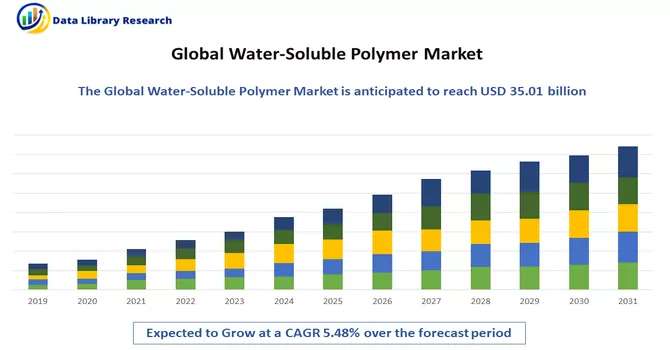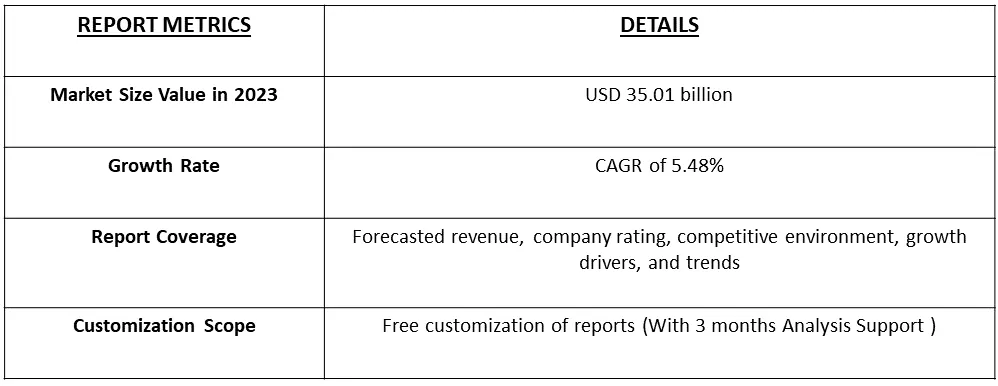The Global Water-Soluble Polymer Market size is expected to grow from USD 35.01 billion in 2023, registering a CAGR of 5.48% during the forecast period (2023-2030).

Get Complete Analysis Of The Report - Download Free Sample PDF
The water-soluble polymer market pertains to the industry involved in the production and supply of polymers or macromolecules with the ability to dissolve or disperse in water. These polymers find applications across various industries, modifying the physical properties of water and other substances. The diverse use of water-soluble polymers spans sectors such as water and wastewater treatment, oil and gas, pharmaceuticals, agriculture, food and beverages, textiles, construction, and more. The market's growth is propelled by increasing environmental concerns and stringent regulations regarding wastewater treatment and pollution control. Additionally, the demand for water-soluble polymers is fueled by the growing need for oil and the desire to enhance production efficiency, especially in applications like enhanced oil recovery (EOR) techniques within the oil and gas industry.
Water-soluble polymers play a pivotal role in wastewater treatment processes. As the focus on efficient and sustainable water and wastewater management intensifies, there is a notable increase in the demand for these polymers in various treatment applications. This trend reflects the industry's response to the evolving needs and standards in environmental conservation. Furthermore, with the rising importance of sustainability, there is a trend towards the development and adoption of biopolymers. These biodegradable water-soluble polymers are derived from renewable sources and offer eco-friendly alternatives to traditional polymers.
Market Segmentation: The Water-soluble Polymer Market is segmented by type (polyacrylamide, polyvinyl alcohol, guar gum, gelatin, xanthan gum, polyacrylic acid, polyethylene glycol, and other types (cellulose ethers, pectin, and starch)), end-user industry (water treatment, food, and beverage, personal care and hygiene, oil, and gas, pulp and paper, pharmaceutical, and other end-user industries), and geography (Asia-Pacific, North America, Europe, South America and Middle-East and Africa). The report offers the market size and forecasts in revenue (USD million) for all the above segments.

For Detailed Market Segmentation - Download Free Sample PDF
Market Drivers:
Environmental Concerns
The ongoing research and technological advancements in polymer chemistry contribute to the development of innovative water-soluble polymers. The new formulations and improved properties enhance the efficiency and applicability of these polymers across various industries. Moreover, increasing awareness of environmental issues and stringent regulations related to wastewater treatment and pollution control drive the demand for water-soluble polymers. These polymers are crucial in addressing water treatment challenges and promoting sustainable practices. Thus, the market is expected to witness significant growth over the forecast period.
Increasing Gas and Oil and Industry
The water-soluble polymer market is significantly influenced by the oil and gas industry, particularly in the application of enhanced oil recovery (EOR) techniques. Water-soluble polymers play a pivotal role in optimizing the efficiency of oil and gas extraction processes. Enhanced oil recovery (EOR) methods are integral to the oil and gas industry for enhancing the extraction of hydrocarbons from reservoirs. Water-soluble polymers constitute a critical element in EOR strategies, where they are injected into oil reservoirs to modify the properties of the injected water.
This modification enhances the water's ability to displace and recover a greater volume of oil. The thickened water, achieved through the incorporation of water-soluble polymers, proves instrumental in displacing oil more effectively. This process significantly improves the rates of oil recovery from reservoirs. Overall, the strategic utilization of water-soluble polymers in the oil and gas industry, particularly in EOR applications, underscores their vital role in enhancing extraction processes and maximizing oil recovery. As a result, the market is expected to witness significant growth over the forecast period.
Market Restraints:
Cost and Price Volatility and Environmental Concerns
The water-soluble polymer market, like any industry, faces certain market restraints that can impact its growth and development. The production of water-soluble polymers involves intricate chemical processes, contributing to a potentially higher manufacturing cost. Moreover, the prices of essential raw materials like monomers and feedstocks are susceptible to volatility, introducing fluctuations in costs and prices that can influence the profitability of manufacturers and end-users alike. Despite their environmentally beneficial applications, notably in water treatment, water-soluble polymers may encounter scrutiny for their environmental impact, especially in terms of disposal and potential persistence in the environment. Thus, the growth of the market is expected to slow down over the forecast period.
The water-soluble polymer market experienced diverse impacts from the COVID-19 pandemic, presenting both challenges and opportunities. The water-soluble polymer market, reliant on a complex supply chain, faced disruptions due to COVID-19. Issues such as factory closures, labor shortages, and transportation restrictions led to interruptions in the supply chain, impacting the availability and pricing of water-soluble polymers. The companies involved in water-soluble polymer production and distribution had to implement health and safety protocols to safeguard their workforce. These measures incurred operational costs and potential disruptions to regular business activities. Thus, the COVID-19 pandemic presented a mix of challenges and opportunities for the water-soluble polymer market, emphasizing the importance of adaptability and innovation in the face of evolving global circumstances.
Segmental Analysis:
Water Treatment Segment is Expected to Witness Significant Growth Over the Forecast period.
Water treatment stands as a crucial application within the water-soluble polymer market, where water-soluble polymers play a pivotal role in various processes and technologies for treating and purifying water. This ensures the water's safety for consumption, industrial use, and environmental discharge. Water-soluble polymers are integral to coagulation and flocculation processes, where they facilitate the aggregation and more rapid settling of particles and impurities in water. This aids in the effective removal of suspended solids, organic matter, and other contaminants from water sources. Moreover, the effectiveness of water-soluble polymers in separating and removing fine particles and colloids from water underscores their significance in water treatment processes. This capability contributes to achieving high-quality water standards. Thus, owing to such advantages, the segment is expected to witness significant growth over the forecast period.
Cellulose Segment is Expected to Witness Significant Growth Over the Forecast period.
Cellulose, a natural polymer, holds a pivotal role in the water-soluble polymer market. Water-soluble polymers derived from cellulose, a compound present in the cell walls of plants, find diverse applications across industries owing to their distinctive properties, including water solubility. Cellulose is inherently hydrophilic, demonstrating a strong affinity for water. This characteristic makes it highly suitable for applications as a water-soluble polymer. The use of cellulose-based water-soluble polymers reflects a commitment to environmental alignment and sustainability. The biodegradability of these polymers contributes to reducing the environmental impact associated with polymer disposal. Moreover, the biodegradability of cellulose-based water-soluble polymers becomes particularly relevant in applications where the ease of disposal is a significant consideration. This aspect supports eco-friendly practices in polymer use. Thus, owing such advantages offered by cellulose polymer, the segment is expected to witness significant growth over the forecast period.
North America Region is Expected to Witness Significant Growth Over the Forecast Period.
The water-soluble polymer market in North America is a dynamic and robust sector that encompasses a wide range of industries and applications. North America, which includes the United States, Canada, and Mexico, is a significant market for water-soluble polymers, driven by various factors and trends. Here are some key aspects of the water-soluble polymer market in North America.
Moreover, North America represents a substantial share of the global water-soluble polymer market. The region's market size and growth are influenced by its diverse industrial landscape, regulatory environment, and technological advancements. Water-soluble polymers are utilized in various applications across North America, including water and wastewater treatment, food and beverages, pharmaceuticals, personal care products, construction, agriculture, and more. The diverse range of applications drives market growth. Thus, owing to such advatnges the segment is expected to witness significant growth over the forecast period.

Get Complete Analysis Of The Report - Download Free Sample PDF
The water-soluble polymer market exhibits a fragmented landscape, with numerous participants collectively holding a significant portion of the market share. Among the notable industry players, some of the key ones include:
Recent Developments:
1) In August 2022, BASF and Nippon Paint China, a leading coatings manufacturer, collaboratively introduced an environmentally friendly industrial packaging solution, adopted by Nippon Paint's dry-mixed mortar series products. Utilizing BASF's water-based acrylic dispersion, Joncryl High-Performance Barrier (HPB), as the barrier material, this innovative packaging material is now commercially available for the construction of Nippon Paint's dry mortar products.
2) In February 2022, Kemira Oyj announced the commencement of worldwide full-scale production of its newly developed polyacrylamide polymer, which is based on biobased feedstock. The initial commercial volumes of this polymer have been shipped to one of the Helsinki Region Environmental Services (HSY) wastewater treatment plants for trial purposes.
Q1. What was the Water-Soluble Polymer Market size in 2023?
The Global Water-Soluble Polymer Market size was USD 35.01 billion in 2023.
Q2. What is the Growth Rate of the Water-Soluble Polymer Market?
Water-Soluble Polymer Market is registering a CAGR of 5.48% during the forecast period.
Q3. Which region has the largest share of the Water-Soluble Polymer market? What are the largest region's market size and growth rate?
North America has the largest share of the market. For detailed insights on the largest region's market size and growth rate request a sample here.
Q4. What segments are covered in the Water-Soluble Polymer market Report?
By Type, Ens User and Geography these are the segments covered in the Water-Soluble Polymer market Report
Data Library Research are conducted by industry experts who offer insight on industry structure, market segmentations technology assessment and competitive landscape (CL), and penetration, as well as on emerging trends. Their analysis is based on primary interviews (~ 80%) and secondary research (~ 20%) as well as years of professional expertise in their respective industries. Adding to this, by analysing historical trends and current market positions, our analysts predict where the market will be headed for the next five years. Furthermore, the varying trends of segment & categories geographically presented are also studied and the estimated based on the primary & secondary research.
In this particular report from the supply side Data Library Research has conducted primary surveys (interviews) with the key level executives (VP, CEO’s, Marketing Director, Business Development Manager and SOFT) of the companies that active & prominent as well as the midsized organization
FIGURE 1: DLR RESEARH PROCESS

Extensive primary research was conducted to gain a deeper insight of the market and industry performance. The analysis is based on both primary and secondary research as well as years of professional expertise in the respective industries.
In addition to analysing current and historical trends, our analysts predict where the market is headed over the next five years.
It varies by segment for these categories geographically presented in the list of market tables. Speaking about this particular report we have conducted primary surveys (interviews) with the key level executives (VP, CEO’s, Marketing Director, Business Development Manager and many more) of the major players active in the market.
Secondary ResearchSecondary research was mainly used to collect and identify information useful for the extensive, technical, market-oriented, and Friend’s study of the Global Extra Neutral Alcohol. It was also used to obtain key information about major players, market classification and segmentation according to the industry trends, geographical markets, and developments related to the market and technology perspectives. For this study, analysts have gathered information from various credible sources, such as annual reports, sec filings, journals, white papers, SOFT presentations, and company web sites.
Market Size EstimationBoth, top-down and bottom-up approaches were used to estimate and validate the size of the Global market and to estimate the size of various other dependent submarkets in the overall Extra Neutral Alcohol. The key players in the market were identified through secondary research and their market contributions in the respective geographies were determined through primary and secondary research.
Forecast Model
